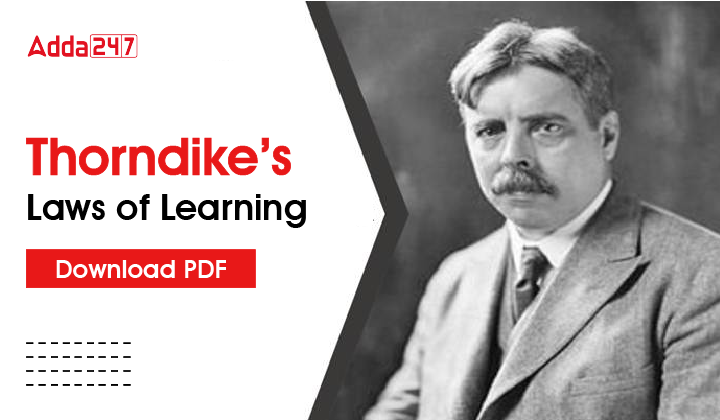Table of Contents
Law of Learning/अधिगम के नियम
Laws of Learning given by Edward Thorndike which are readiness, exercise and effect. Here we divide laws of learning in 2 parts i.e. Primary and secondary. As Learning is a complex process, laws of learning b Thorndike makes them easy to learn and understand. Lets learn here Thorndike’s laws of learning which helps us more in details.
There are mainly two laws of learning.
मुख्यतः अधिगम के नियमो को 2 भागों में बाँटा जा सकता है:
- (A) The Primary Laws of Learning अधिगम के प्राथमिक नियम
- (B) The Secondary Laws of Learning अधिगम के माध्यमिक नियम
The Primary laws of Learning अधिगम के प्राथमिक नियम
- Law of Readiness: Readiness implies physical and mental preparedness to undertake a task. Readiness is the basis of learning. The more eager a person is to accomplish a take the quicker her learns. The person is a state of readiness at once assimilates the material concerning the job. A person who is not ready to learn cannot learn effectively.
तत्परता का नियम: तत्परता से तात्पर्य शारीरिक और मानसिक तैयारी से है। तत्परता अधिगम का आधार है। एक व्यक्ति जितना अधिक उत्सुक होता है वह अपने अधिगम की त्वरितता को पूरा करता है। एक बार व्यक्ति नौकरी के विषय में सामग्री को आत्मसात कर लेता है। एक व्यक्ति जो सीखने के लिए तैयार नहीं है, वह प्रभावी रूप से नहीं सीख सकता है.
Education Implications: The following is the nature of the contribution of the law of readiness in the field of education: शिक्षा के निहितार्थ: शिक्षा के क्षेत्र में तत्परता के कानून के योगदान की प्रकृति निम्नलिखित है:
- To Motivate the students छात्रों को प्रेरित करने के लिए
- To Arouse Interest रुचि जगाने के लिए
- Law of Exercise : According to Thorndike the law of exercise is foremost in the process of learning. If a response to a stimulus is repeated again and again, a connection gets established between the stimulus and the response. This connection firm up with practice and weakens with disuse. A person learns by practice and repetition. This is the law of exercise as propounded by Thorndike.
अभ्यास का नियम: थार्नडाइक के अनुसार सीखने की प्रक्रिया में व्यायाम का नियम सबसे महत्वपूर्ण है। यदि किसी उत्तेजना की प्रतिक्रिया बार-बार दोहराई जाती है, तो उत्तेजना और प्रतिक्रिया के बीच एक संबंध स्थापित हो जाता है। यह संबंध अभ्यास के साथ मजबूत होता है और दुरुपयोग के साथ कमजोर होता है। एक व्यक्ति अभ्यास और दोहराव से सीखता है। यह थार्नडाइक द्वारा प्रतिपादित अभ्यास का नियम है.
The law of exercise has two sub parts: अभ्यास के नियम के 2 भाग हैं:
- Law of use : According to the law of use, in the words of Thorndike : “when a modifiable connection is made between a situation and response that connection’s strength is, other things being equal, increased.
उपयोग का नियम: उपयोग के नियम के अनुसार, थार्नडाइक के शब्दों में: जब एक स्थिति और प्रतिक्रिया के बीच एक परिवर्तनीय संबंध बनाया जाता है, जो कि संबंध की ताकत है, तो अन्य चीजें समान रूप से बढ़ जाती हैं।
- Law of Disuse : According to the law of disuse again in the words of Thorndike: “When modifiable connection is not made between a situation and response, during a length to time, that connection’s strength is decreased”.
अनुपयोग का नियम: “थार्नडाइक के शब्दों में प्रयोग के नियम के अनुसार: जब किसी स्थिति और प्रतिक्रिया के बीच लम्बे समय के दौरान परिवर्तनशील संबंध नहीं बनाया जाता है, तो उस संबंध की शक्ति कम हो जाती है.”
Educational Implications : The law of exercise contributes in the following manner to education : शिक्षा के निहितार्थ: अभ्यास का नियम निम्नलिखित तरीके से शिक्षा में योगदान देता है.
- Formation of Good Habits/अच्छी आदतों का गठन
- Eradication of Bad Habits/बुरी आदतों का उन्मूलन
- Correct Pronunciation/ सही उच्चारण
- Improvement in Handwriting/लिखावट में सुधार
- Development of skills/कौशल का विकास
- Law of Effect : This law is also known as the law of satisfaction and dissatisfaction. Success and failure impact the process of learning. If a learner meets with success, he has a sense of satisfaction. And if failure comes his way, he feels depressed and dissatisfied. Satisfaction strengthens association and dissatisfaction has a contrary effect. According to the law of effect reward encourages learning and punishment has a reverse effect. For example the accomplishment of a task gives pleasure and the learner likes to do it over and over again.
प्रभाव का नियम: इस नियम को संतुष्टि और असंतोष के कानून के रूप में भी जाना जाता है। सफलता और विफलता अधिगम की प्रक्रिया को प्रभावित करती है। यदि एक शिक्षार्थी सफलता के साथ मिलता है, तो उसके पास संतोष की भावना होती है। और अगर असफलता अपने रास्ते पर आती है, तो वह उदास और असंतुष्ट महसूस करता है। संतोष संघ को मजबूत करता है और असंतोष का विपरीत प्रभाव पड़ता है। प्रभाव के नियम के अनुसार इनाम अधिगम को प्रोत्साहित करता है और सजा का उल्टा प्रभाव पड़ता है। उदाहरण के लिए किसी कार्य की सिद्धि आनंद देती है और सीखने वाला उसे बार-बार करना पसंद करता है.
Educational Implications of laws of learning
The law of effect contributes to education in the following manner : शिक्षा के निहितार्थ: प्रभाव का नियम निम्नलिखित तरीके से शिक्षा में योगदान देता है
- Formation of good Habits and Attitudes
- Pleasant Experience
- Emotions
- From Easy to difficult
- Novelty
- Eradication of Delinquent behaviour
- Praise and Encouragement
- अच्छे आवास और दृष्टिकोण का गठन
- सुखद अनुभव
- भावनाएँ
- आसान से मुश्किल तक
- नवीनता
- नाजुक व्यवहार का उन्मूलन
- प्रशंसा और प्रोत्साहन
The Secondary Laws of learning अधिगम के माध्यमिक नियम
The following are the secondary laws of learning as propounded by Thorndike: थार्नडाइक द्वारा प्रतिपादित शिक्षा के माध्यमिक नियम निम्नलिखित हैं:
1. Law of Multiple response: This law implies that if a new problematic situation presents itself before an individual (or a being) he / it responds to it in a variety of ways, the response having been based on previous experiences, to solve the problem. These diverse responses finally lead him on to the correct response provoked, one after the other, until success is achieved. This is known as a law of multiple response.
बहु प्रतिक्रिया का नियम: इस नियम का तात्पर्य यह है कि यदि कोई नई समस्याग्रस्त स्थिति किसी व्यक्ति (या किसी के) के समक्ष प्रस्तुत करती है तो वह उसे कई तरह से जवाब देता है, प्रतिक्रिया पिछले अनुभवों पर आधारित होती है, समस्या को हल करने के लिए। ये विविध प्रतिक्रियाएँ अंत में उसे सही प्रतिक्रिया के लिए उकसाती हैं, एक के बाद एक जब तक सफलता नहीं मिलती। यह बहु प्रतिक्रिया के नियम के रूप में जाना जाता है.
2. Law of Mental Set or Law of Attitude: The law of mental set is also known as the law of attitude. How an organism will respond to a specific stimulus depends of the learner’s attitude or mental set. One learner may be very keen to learn a task and another individual may have no interest in learning the task for example if a person hates the English language and hates also the English people he will be lacking in the aptitude for the language, therefore, this law of attitude points to the mental set or attitude of an individual.
मानसिक स्थिति का नियम या अभिवृति का नियम: मानसिक स्थिति के नियम को अभिवृति के नियम के रूप में भी जाना जाता है। एक जीव एक विशिष्ट उत्तेजना का जवाब कैसे देगा यह सीखने वाले के दृष्टिकोण या मानसिक स्थिति पर निर्भर करता है। एक शिक्षार्थी किसी कार्य को सीखने के लिए बहुत उत्सुक हो सकता है और किसी अन्य व्यक्ति को उदाहरण के लिए कार्य को सीखने में कोई दिलचस्पी नहीं हो सकती है यदि कोई व्यक्ति अंग्रेजी भाषा से नफरत करता है और वह भी अंग्रेजी लोगों से नफरत करता है जो भाषा के लिए योग्यता की कमी होगी, इसलिए यह दृष्टिकोण का नियम किसी व्यक्ति की मानसिक स्थिति या रवैये की ओर इशारा करता है.
3. Law of Partial Activity: An individual responds in a variety of wats in order to solve a problem, depending of the theory of Trial and Error, In the process the law of partial activity, the organism does not have to go into the depth of the problem. He perceives the main elements of the problem and reacts according to them. This is what Thorndike maned as the law of partial activity.
आंशिक गतिविधि का नियम: ट्रायल और एरर के सिद्धांत के आधार पर कोई व्यक्ति किसी समस्या को हल करने के लिए कई प्रकार के वाट्स में प्रतिक्रिया करता है, इस प्रक्रिया में आंशिक गतिविधि के कानून में, जीव को समस्या की गहराई में जाने की जरूरत नहीं है। वह समस्या के मुख्य तत्वों को मानता है और उनके अनुसार प्रतिक्रिया करता है। यह वही है जो थार्नडाइक ने आंशिक गतिविधि के कानून के रूप में काम किया.
4. Law of Assimilation or Law of Analogy: The law of assimilation is also known as the law of analogy. A new situation provokes similar responses in an individual that he had made earlier in similar situations and had met with success. This is what Thorndike called the law of assimilation of the law of analogy.
आत्मसात्करण का नियम या सादृश्यता का नियम: आत्मसात के नियम को सादृश्य के नियम के रूप में भी जाना जाता है। एक नई स्थिति एक व्यक्ति में समान प्रतिक्रियाओं को उकसाती है जो उसने पहले भी इसी तरह की परिस्थितियों में की थी और सफलता के साथ मिली थी। इसे थार्नडाइक ने आत्मसात का नियम या सादृश्य का नियम कहा है.
5. Law of associative Shifting: According to this law a response evoked by a stimulus can be associated with any other possible stimulus. Thorndike in this context has said: “We can get any response from the learner of which he is capable, associated with any situation to which he is sensitive.” He has expressed the conditioning Response in the form of law of associative shifting.
सहयोग स्थानांतरण का नियम: इस कानून के अनुसार एक उत्तेजना द्वारा पैदा की गई प्रतिक्रिया किसी अन्य संभावित उत्तेजना से जुड़ी हो सकती है। थार्नडाइक ने इस संदर्भ में कहा है: हम सीखने वाले से कोई भी प्रतिक्रिया प्राप्त कर सकते हैं, जो वह सक्षम है, किसी भी स्थिति से जुड़ा हुआ है, जिसके प्रति वह संवेदनशील है। उन्होंने सहयोग स्थानांतरण के नियम के रूप में अनुबंधन प्रतिक्रिया व्यक्त की है.
6. Law of Recency: According to this law, new things are learnt rapidly, such as revision of the books before examination.
नवीनता का नियम: इस कानून के अनुसार, नई चीजों को तेजी से सीखा जाता है, जैसे कि परीक्षा से पहले किताबों का रिविजन.
7. Law of primary Efforts: It is well said that the first impression is the last impression. Hence, in the beginning stage, the acquired impression is permanent. therefore children & the teacher should be serious from the very beginning.
प्राथमिक प्रयासों का कानून: यह अच्छी तरह से कहा जाता है कि पहली छाप अंतिम धारणा है। इसलिए, शुरुआती चरण में, अधिग्रहित धारणा स्थायी है। इसलिए बच्चों और शिक्षक को शुरू से ही गंभीर होना चाहिए.
8. Law Belongingness: This Law tells us that if the answer is relevant to the situation, then this relation can be memorized very rapidly.
अपनेपन का नियम: यह कानून हमें बताता है कि यदि उत्तर स्थिति के लिए प्रासंगिक है, तो यह संबंध बहुत तेजी से याद किया जा सकता है
9. Law of intensity of Stimulus: According to this law if the stimulus is intense, his response would also be intense. If the stimulus is weak, then its response would also be weaker. In schools, the examinations act as strong stimuli for students.
उत्तेजना की तीव्रता का नियम: इस नियम के अनुसार यदि उत्तेजना तीव्र है, तो उसकी प्रतिक्रिया भी तीव्र होगी। यदि उत्तेजना कमजोर है, तो उसकी प्रतिक्रिया भी कमजोर होगी। स्कूलों में, परीक्षाएं छात्रों के लिए मजबूत उत्तेजना का काम करती हैं।
Law of Learning Notes PDF
Candidates preparing for Teaching Exams can easily access the Law of Learning Notes PDF file from the link provided below. They can refer to the PDF as a reference during preparation and most importantly during revisions.



 HTET Application Form 2026 Out @htet.eap...
HTET Application Form 2026 Out @htet.eap...
 UP Junior Aided Merit List PDF 2026 Out,...
UP Junior Aided Merit List PDF 2026 Out,...
 HTET Syllabus 2026 (TGT, PGT, PRT), Chec...
HTET Syllabus 2026 (TGT, PGT, PRT), Chec...












